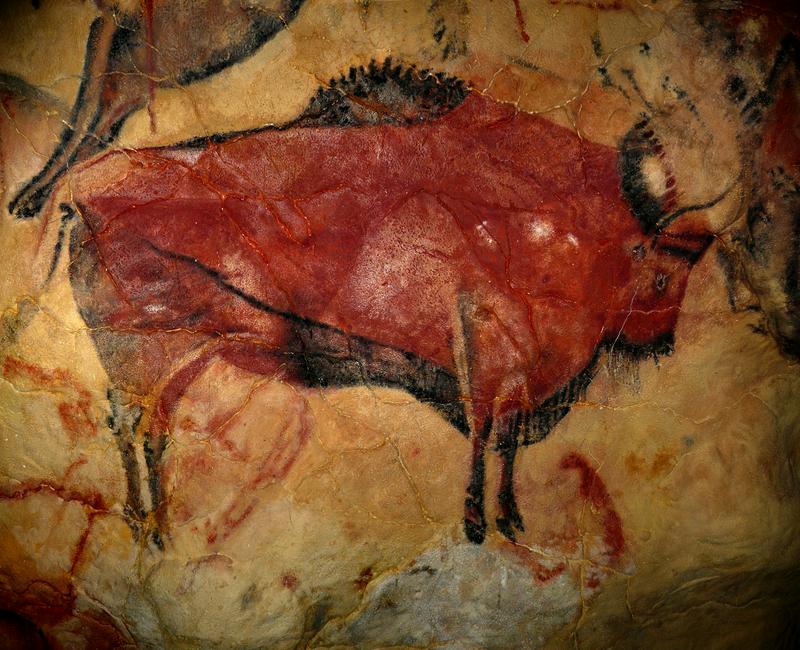Art in Unusual Places
By | November 14, 2018

While canvas may now be considered the most common surface for painting, artists did not begin using it until the 15th Century. In the more distant past, artists had to be a bit more creative in choosing a location for their masterpieces.
Our oldest ancestors created paintings on cave walls using dirt or charcoal mixed with animal fat as their paint. This was an odd choice as early man was nomadic and would, therefore, be forced to leave the paintings behind when it was time to move on. However, their options were limited as paper had not yet been invented. It is also likely that the paintings served a purpose other than decoration. While we may not be able to ascertain their true purpose, there are several theories of what it might be. One theory regarding the paintings of animals such as the one in the above image is that they believed painting the animal was a way to capture their spirit and would make them easier to hunt. Other theories suggest the paintings were a means of communication as well as a way to preserve their history.
But the nomads were not the only ones to paint in dark places, where no living soul was likely to see it.

Even stranger than painting a cave wall is the idea of painting the wall of a tomb, considering the intended inhabitant is deceased and unable to appreciate the effort. However, this is exactly what the ancient Egyptians did. Like the cave paintings of the nomads, the tomb paintings of ancient Egypt served a purpose beyond the aesthetic. The Egyptians believed that the function of the tomb was to transport the soul to the afterlife. As a result, many of the paintings were actually narratives to guide the deceased through the underworld. The paintings, like the one above which was found in the tomb of Hetpet, often depicted the deceased living a happy and fulfilled life. They believed the soul could draw on these images in the afterlife to satisfy their needs and ensure a contented eternity.
The ancient Egyptians are not known solely for painting in tombs; they are also credited with the discovery of glass. However, the first civilization to begin the art of staining glass is unknown.

While its origins are uncertain, the art of staining glass peaked in the Middle Ages as churches filled their windows with picturesque illustrations of biblical narratives. Despite their beauty, the idea of putting artwork on a window is peculiar considering one of a window’s primary purposes is to be transparent. Not to mention how easily it could get broken. Though it would seem the glass is rather resilient, as images like the one above from Chartres Cathedral in France have survived centuries.
But churches did not stop at just decorating their windows. Eventually, they began painting the ceilings as well.

The above image is one on nine scenes painted by Michelangelo in the early 1500s on the ceiling of the Sistine Chapel in Vatican City. Unlike the artists of ancient times, Michelangelo, who was primarily a sculptor, did not choose a ceiling as the surface for his work for lack of another option. He took the commission to paint the ceiling of the Sistine Chapel at the insistence of Pope Julius II, who was a renowned patron of the arts. Not only was this an unusual location for a painting, but it was also a challenging undertaking, particularly for an artist in the 16th century. Reaching the ceiling of the Sistine Chapel first required the construction of a scaffold. It was also likely a painful experience as Michelangelo had to paint with his head tilted upwards. Nevertheless, he completed his masterpiece, which has achieved the status of one of the most well-known artistic creations of the High Renaissance period.
Today, art can be found anywhere and on anything, from giant portraits painted directly onto the surface of the Earth to tiny images on grains of rice.

As evidenced in the image above, which depicts Starry Night by Vincent Van Gogh, we literally have art at the tips of our fingers. The famous painting has been reproduced in a number of ways, including cell phone cases, credit cards and handbags, just to name a few. Pretty much anywhere you can think of to make art, someone has done it just to prove they can. And then they’ve photographed it and posted it online, thus putting their art in yet another strange location – a computer screen.
But the artists of old did not have the technology today to mass produce their work nor did they have they have easy access to traditional surfaces like canvas. They had to make do with what they had, even if all they had was the earth and their own bodily fluids.

